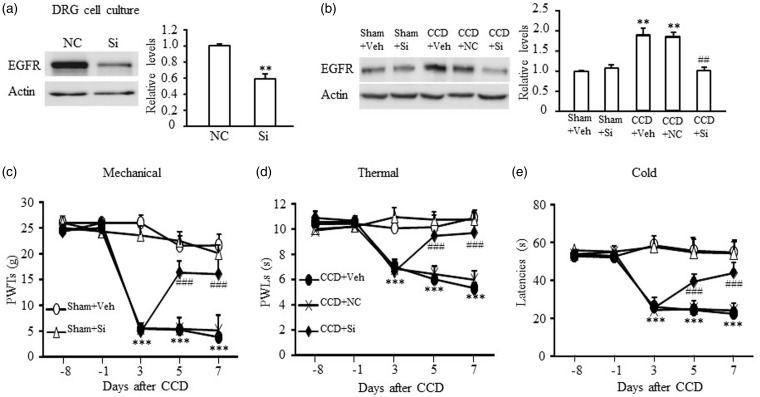Figure 4.
Effect of EGFR siRNA (Si) on CCD-induced nociceptive hypersensitivities. (a) The expression level of EGFR protein was markedly reduced by treating with EGFR siRNA (250 nM) in in vitro DRG cell culture. N = 3 repeats (six wells from three rats) per treatment. *P < 0.01 versus NC siRNA by two-tailed unpaired Student’s t test. (b) Intrathecal injection of EGFR siRNA (10 µM in 10 µl) blocked the increase of EGFR induced by CCD and did not affect the basal expression of EGFR in sham group. The first injection starts on day 3 post-CCD and once daily for four days. Ipsilateral L4/L5 DRGs were harvested on day 7 after surgery. N = 3 rats/time point. One-way ANOVA (effect vs. the treated groups) followed by post hoc Tukey test, **P < 0.01, ***P < 0.001 versus the sham + Veh group. ##P < 0.01 or ###P < 0.001 versus the CCD + Veh group. Intrathecal injection of EGFR siRNA reversed the decrease of PWTs to mechanical stimulation (c), PWLs to thermal stimulation (d), or positive response latencies to cold stimulation (e) on the ipsilateral side in CCD rats. N = 6 rats/group. Two-way RM ANOVA (effect vs. group × time interaction) followed by post hoc Tukey test. ***P < 0.001 versus the corresponding time point in the sham + Veh group. ###P < 0.001 versus the corresponding time point in the CCD + Veh or the CCD + NC group. CCD: chronic compression of DRG; DRG: dorsal root ganglion; EGFR: epidermal growth factor receptor; NC: negative control; PWL: paw withdrawal latency; PWT: paw withdrawal threshold.

